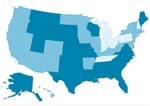government
Ohio governor proposes Medicaid shared savings
■ Gov. John Kasich also wants a single care manager and benefits access point for people eligible for both Medicare and Medicaid.
Ohio Gov. John Kasich has begun a dual effort to transform the state's Medicaid program to pay based on the quality and coordination of care provided to enrollees.
In early January, the Ohio Governor's Office of Health Transformation announced that it was seeking public and stakeholder input on a proposal to create a single point of benefits administration for Ohioans who are eligible for both Medicare and Medicaid. The state also is rebidding its Medicaid managed care contracts to emphasize quality beginning in 2013. The Ohio Legislature endorsed these and other goals in a budget bill adopted in 2011.
"In Ohio and across the country, we must do a better job of meeting the health needs of individuals and creating a healthy and productive work force at a price that is affordable for businesses, governments, individuals, and other payers," said Greg Moody, director of the governor's health transformation office.
Kasich proposed creating a single point for benefits administration for the 190,000 Ohioans eligible for Medicare and Medicaid. Typically, Medicare pays for doctor and hospital visits and prescription drugs for these dual-eligible beneficiaries. Medicaid mostly pays for their long-term care, including nursing home stays.
The Kasich administration's draft dual-eligible proposal -- called an Integrated Care Delivery System -- would assign each beneficiary to a care manager to ensure seamless care transitions. The program also would include periodic home visits with enrollees, aggressive reviews of hospital admissions and nursing home placements, and a centralized record for each beneficiary.
Ohio's proposal is based on its application for one of 15 federal grants of up to $1 million to design dual-eligible care programs. In April 2011, the federal Centers for Medicare & Medicaid Services awarded the grants, which were made available through the national health system reform law. Ohio was not an awardee.
The Ohio dual-eligible proposal would solicit bids from outside organizations to provide care to the beneficiaries. It requires federal approval, but CMS has outlined two paths states can take regarding such programs, according to Ohio Medicaid director John McCarthy A dual-eligible managed care program -- Ohio's choice -- would allow state and federal health officials to set program capitation rates in advance to achieve a savings target. A fee-for-service program would not include a maximum budget but would share savings generated in the previous year through care coordination and other efforts, he said.
McCarthy said physician- or hospital-directed accountable care organizations could bid to care for dual eligibles, but that the work will not be easy. "Setting capitation rates and measuring risk isn't going to be straightforward in this population," he said.
McCarthy said the state does not want to achieve savings by reducing Medicaid physician fees, but wants physicians to benefit from gains in quality and efficiency by sharing in the savings.
The governor's office has listened to physicians while crafting the proposals, said Tim Maglione, senior director for government relations for the Ohio State Medical Assn. "We feel that we have the opportunity for meaningful input on the development of this program." The state began two months of public input meetings on Jan. 12, McCarthy said.
Nationwide, 9 million people are eligible for both Medicare and Medicaid, according to CMS. These beneficiaries account for a disproportionate share of the $300 billion in annual Medicare and Medicaid spending. More than 2.1 million people are enrolled in Ohio's Medicaid program. Seven managed care plans serve more than 1.6 million Medicaid enrollees, including 125,000 aged, blind and disabled people, and 37,000 children with special needs, according to Kasich's office.
The Ohio State Medical Assn. has not adopted formal positions on either proposal, but the state's emphasis on quality and administrative simplification are good goals, Maglione said, adding, "I do think they're on the right track." Maglione also said he believes the state will hold managed care plans accountable for their quality performance.
Many Ohio physicians continue to see Medicaid patients even though state fees sometimes do not cover physicians' costs, Maglione said. Ohio Medicaid physician fees are between 65% and 70% of Medicare rates, although some Medicaid managed care plans pay more to ensure adequate networks.
More information about the Ohio reform plans are available online from the governor's Office of Health Transformation (link). Information also is available from the Catalyst for Payment Reform website (link).












